Ascanius may refer to:
- In Classical mythology:
- Ascanius, a genus of bugs in the subfamily Pachycorinae
- Lake Ascanius in Anatolia.
- Peter Ascanius (1723–1803), Norwegian biologist.
- Domenicus van Wijnen, called Ascanius (1661 – c.1695), Dutch painter.
Ascanius may refer to:

In Greco-Roman mythology, Aeneas was a Trojan hero, the son of the Trojan prince Anchises and the Greek goddess Aphrodite. His father was a first cousin of King Priam of Troy, making Aeneas a second cousin to Priam's children. He is a minor character in Greek mythology and is mentioned in Homer's Iliad. Aeneas receives full treatment in Roman mythology, most extensively in Virgil's Aeneid, where he is cast as an ancestor of Romulus and Remus. He became the first true hero of Rome. Snorri Sturluson identifies him with the Norse god Víðarr of the Æsir.
Julus may refer to:
In Greek mythology, Creusa may refer to the following figures:
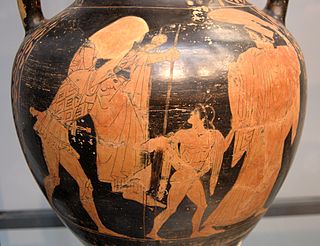
Ascanius was a legendary king of Alba Longa and is the son of the Trojan hero Aeneas and Creusa, daughter of Priam. He is a character in Roman mythology, and has a divine lineage, being the son of Aeneas, who is the son of the goddess Venus and the hero Anchises, a relative of the king Priam; thus Ascanius has divine ascendents by both parents, being descendants of god Jupiter and Dardanus. He is also an ancestor of Romulus, Remus and the Gens Julia. Together with his father, he is a major character in Virgil's Aeneid, and he is depicted as one of the founders of the Roman race.
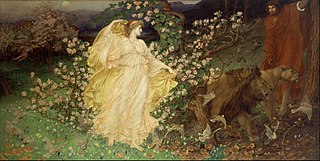
In Greek and Roman mythology, Anchises was a member of the royal family of Troy. He was said to have been the son of King Capys of Dardania and Themiste, daughter of Ilus, who was son of Tros. He is most famous as the father of Aeneas and for his treatment in Virgil's Aeneid. Anchises' brother was Acoetes, father of the priest Laocoön.
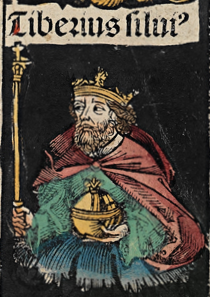
Tiberinus was the ninth king of Alba Longa, according to the traditional history of Rome handed down by Titus Livius. He was the successor of Capetus, the eighth king of Alba Longa. The Alban kings claimed descent from Aeneas, a Trojan prince who brought a remnant of the Trojan populace to Italy following the sack of Troy, and settled in Latium. Alba was built by Ascanius, the son of Aeneas and Lavinia, and founder of the Alban royal line. The Alban kings, including Tiberinus, bore the cognomenSilvius, after the son of Ascanius, who was said to have been born in the woods.

In Roman mythology, Lavinia is the daughter of Latinus and Amata, and the last wife of Aeneas.
In Roman mythology, the Aeneads were the friends, family and companions of Aeneas, with whom they fled from Troy after the Trojan War. Aenides was another patronymic from Aeneas, which is applied by Gaius Valerius Flaccus to the inhabitants of Cyzicus, whose town was believed to have been founded by Cyzicus, the son of Aeneas and Aenete. Similarly, Aeneades was a patronymic from Aeneas, and applied as a surname to those who were believed to have been descended from him, such as Ascanius, Augustus, and the Romans in general.
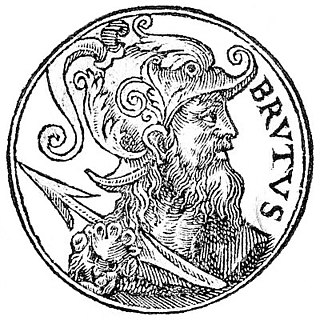
Brutus, also called Brute of Troy, is a mythical British king. He is described as a legendary descendant of the Trojan hero Aeneas, known in medieval British legend as the eponymous founder and first king of Britain. This legend first appears in the Historia Brittonum, an anonymous 9th-century historical compilation to which commentary was added by Nennius, but is best known from the account given by the 12th-century chronicler Geoffrey of Monmouth in his Historia Regum Britanniae.
The Trojan genealogy of Nennius was written in the Historia Brittonum of Nennius and was created to merge Greek mythology with Christian themes. As a description of the genealogical line of Aeneas of Troy, Brutus of Britain, and Romulus and Remus, the founders of Rome, it is an example of the foundation genealogies found not only in early Irish, Welsh and Saxon texts but also in Roman sources.

Dido, Queen of Carthage is a short play written by the English playwright Christopher Marlowe, with possible contributions by Thomas Nashe. It was probably written between 1587 and 1593, and was first published in 1594. The story focuses on the classical figure of Dido, the Queen of Carthage. It tells an intense dramatic tale of Dido and her fanatical love for Aeneas, Aeneas' betrayal of her and her eventual suicide on his departure for Italy. The playwrights relied on Books 1, 2, and 4 of Virgil's Aeneid as primary source.

Aeneas, Anchises, and Ascanius is a sculpture by the Italian artist Gian Lorenzo Bernini created c. 1618–19. Housed in the Galleria Borghese in Rome, the sculpture depicts a scene from the Aeneid, where the hero Aeneas leads his family from burning Troy.

Peter Ascanius was a Norwegian-Danish biologist and geologist. He was a professor of zoology and mineralogy.

Lake İznik is a freshwater lake in the Province of Bursa, Turkey. It is around 32 km in length and 10 km in width with a maximum depth of about 80 m. The town of Iznik lies at its eastern end. The lake's Ancient Greek name was Askania (Ἀσκανία); the Latin name was Ascania.

The kings of Alba Longa, or Alban kings, were a series of legendary kings of Latium, who ruled from the ancient city of Alba Longa. In the mythic tradition of ancient Rome, they fill the 400-year gap between the settlement of Aeneas in Italy and the founding of the city of Rome by Romulus. It was this line of descent to which the Julii claimed kinship. The traditional line of the Alban kings ends with Numitor, the grandfather of Romulus and Remus. One later king, Gaius Cluilius, is mentioned by Roman historians, although his relation to the original line, if any, is unknown; and after his death, a few generations after the time of Romulus, the city was destroyed by Tullus Hostilius, the third King of Rome, and its population transferred to Alba's daughter city.

Philinidae is a family of medium-sized sea slugs, marine opisthobranch gastropod mollusks. These are headshield slugs, in the order Cephalaspidea.
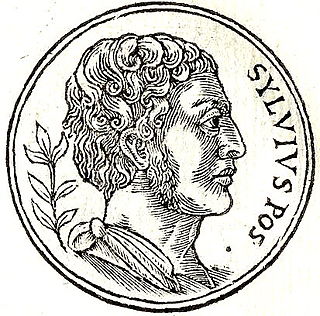
In Roman mythology, Silvius or Silvius Postumus, was either the son of Aeneas and Lavinia or the son of Ascanius. He succeeded Ascanius as King of Alba Longa and reigned 1139–1110 BC.
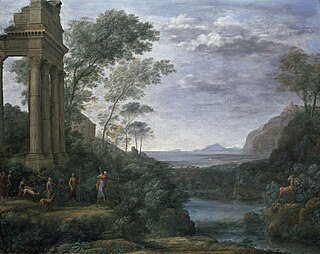
Landscape with Ascanius Shooting the Stag of Sylvia is a painting of 1682 in oil on canvas by Claude Lorrain, a painter from the Duchy of Lorraine who spent his career in Rome. It was painted in Rome for Prince Lorenzo Onofrio Colonna (1637–1689), Claude's most important patron in his last years, and is now in the Ashmolean Museum, Oxford. It is signed, dated with the year, and inscribed with the subject, as Claude sometimes did with his less common subjects.

The red-tailed monkey, also known as the black-cheeked white-nosed monkey, red-tailed guenon, redtail monkey, or Schmidt's guenon, is a species of primate in the family Cercopithecidae.

In Greek and Roman mythology, Creusa is the wife of Aeneas, and the mother of Ascanius. According to Apollodorus, she is the daughter of Priam and Hecuba. A number of sources describe her presence during the sack of Troy, with her often fleeing the city alongside her husband. In Virgil's Aeneid, Creusa is lost in the confusion while their family is trying to escape, leading Aeneas to turn back to look for her; there he is met with her shade, which foretells of his future journey to Hesperia, where he is told he will marry a different woman.